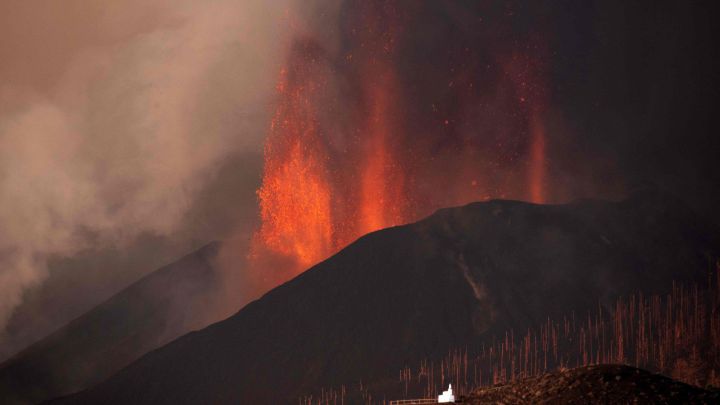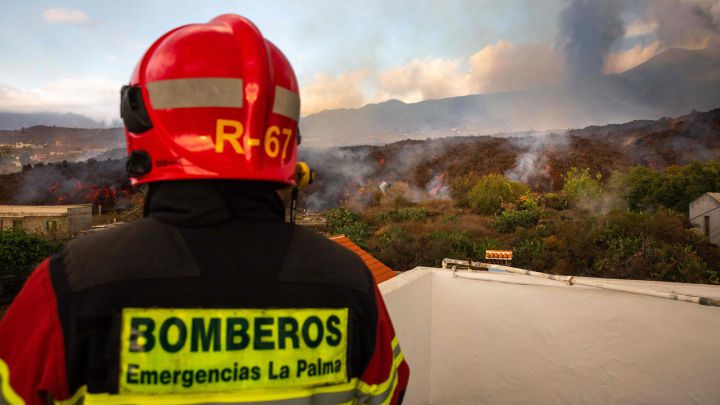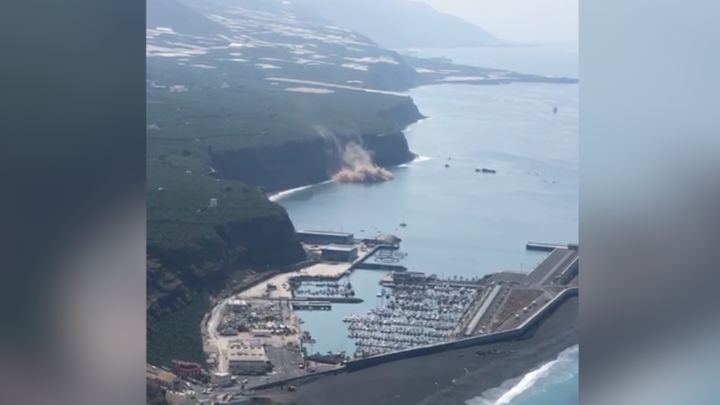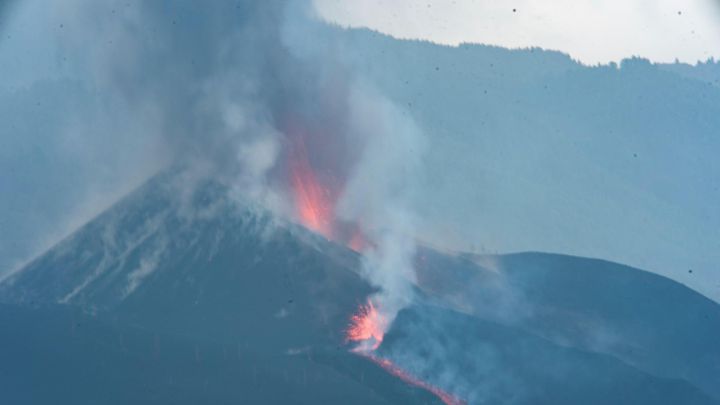La Palma volcano eruption | news summary for Tuesday 29 September
The eruption of La Palma's Cumbre Vieja volcano has intensified and is close to reaching the sea. Breaking news and updates from the Canary Islands.
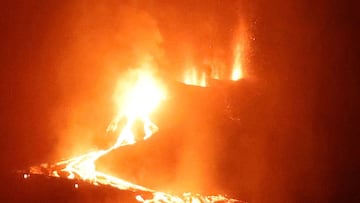
Show key events only
La Palma volcano eruption: live updates
Headlines
- Lava reached the ocean on Tuesday, leaving behind a path of destruction.
- Spain approves $12.2 million aid package for La Palma
- Spanish volcanologist explains what will happen when the lava reaches the sea on La Palma. (Details)
- Over 500 buildings destroyed by lava flow
- Villages of Tacande and Tajuya evacuated amid increased explosive activity and new vents. Ash plume now 4km high
- New lava flow caused by cone fracture moving "more quickly and more fluidly"
- Lava flow "advancing quickly towards the coast", says president of La Palma local government
- Active volcanoes in the Canary Islands: an overview
- When was the last volcanic eruption in the Canary Islands? (Details)
- The question on many minds: What happens when the lava reaches the ocean? (Details)
Related articles:
Rare Images of the La Palma volcano at dusk emerge
After a quite weekend, the Volcano activly erupting in the Canary Isalnds, began to pick up steam. Photographers captured stunning images of the scene at dusk,
Spanish volcanologist explains what will happen when the lava reaches the sea on La Palma
Reports from La Palma are in, and the moment many have been waiting for is almost here: the lava will soon reach the ocean. Want to know what reaction it will have? Read our full coverage.
The miracle house
One home in La Palma has been dubbed 'casa milagro' (the miracle house) after it managed to narrowly avoid being engulfed buy the lava flow that has so far destroyed more than 500 buildings...

An onlooker takes a photo of the cloud of smoke billowing out of one of the craters of the Cumbre Vieja volcano. (Photo: EFE)

A screengrab from a drone footage shows the extent of the damage caused by the lava streams flowing from the Cumbre Vieja volcano, on the Canary Island of La Palma, Spain September 28, 2021. (Reuters)
€5.5m to be used to buy 107 homes
Following the Spanish government's approval of a €10.5m ($12.2m) aid package, it has been confirmed that€5.5m of the designated money will be used to by 107 dwellings for those who have lost their homes as a result of the Cumbre Vieja volcanic eruption.

Six earthquakes detected in area round volcano
Spain's Instituto Geográfico Nacional (IGN) has detected six earthquakes in the area affected by the volcanic eruption of Cumbre Vieja, on La Palma, with a maximum recorded magnitude of 2.9 in a seismic movement that occurred 10 kilometers deep. (Photo: Reuters)

Farmers despair as volcano ravages La Palma's banana crop
In more than 50 years growing bananas on the Spanish island of La Palma, Antonio Brito Alvarez has never seen anything like the devastation wrought by the Cumbre Vieja volcano, which has been spewing out molten rock and ash since last Sunday and now farmers such as Alvarez are worried the impact the volcano will have on their banana crop.

Bathers on Tazacorte beach relax as Cumbre Vieja erupts
Bathers on Tazacorte beach, a few kilometres away from the volcano on La Palma impact zone, remained calm.
"I'm not afraid. The beach is relaxing," Maria Lourdes, who lived through La Palma's last big eruption in 1971, told Reuters as a few bathers and families with young children strolled along the black sands.
Further inland, one resident who was evacuated last week from the village of Tacande de Arriba was delighted to find his house still standing and his pet cats unscathed.
"It's a good feeling, a fantastic feeling," said Gert Waegerle, 75, who fled the advancing lava with his five turtles on Friday but had to leave the cats behind. "I am super happy because in the end, everything turned out fine."

Spanish government pledges aid to La Palma as erratic eruption keeps island guessing
Spain classified La Palma as a disaster zone on Tuesday, a move that will trigger financial support for the island where a volcanic eruption has wrecked buildings and destroyed crops over the past nine days.
The government announced a first package of 10.5 million euros ($12.30 million), which includes around 5 million euros to buy houses, with the rest to acquire furniture and essential household goods, government spokesperson Isabel Rodriguez said.
Lava has been flowing down the volcano's western flank toward the sea since Sept. 19, destroying almost 600 houses and banana plantations in La Palma, which neighbours Tenerife in the Canary Islands archipelago off the North African coast.
Accumulated ash danger on La Palma if it rains
The streets of La Palma have been stained grey and black for a week due to the ash falling from the Cumbre Vieja volcano, causing serious problems to the citizens and generating a threat for October, when the rains will arrive on the island. This is the warning coming from the spokesman for the Volcanological Institute of the Canary Islands (Involcal), David Calvo, today.
The volcanologist pointed out that plans need to be made about what to do with all this ash because so much has fallen that in some areas cars have even run aground. He also warned that when the ash gets wet, its weight is incredible and it could pull down a building. For this reason, he has raised the need to access the evacuated areas in order to clean both the entrances and the houses, as the ash "soaks up everything".
To facilitate the work of the emergency services working there, there has been renewed focus on the cleaning of the ash on the roads and evacuation routes, a task in which the island's local councils are collaborating, as well as the councils of Gran Canaria and Tenerife, which have sent snowploughs.
María José Blanco, director of the National Geographic Institute in the Canary Islands (IGN), said today after the meeting of the Canary Islands Volcanic Risk Prevention Plan (PEVOLCA) that the new north-facing lava flow has "a higher emission rate."
This flow "runs along previous lava path, so it is advancing further and has reached the centre of Todoque at a distance of two kilometres from the coast, not in a straight line, but following the path of maximum probability," explained Blanco.
She also explained that the volcanic eruption continues with "a more effusive character" than previous ones and that the volcano, as of 19:15 Monday, began to emit lava flows similar to "Hawaiian activity".
Lava remains around a kilometer from coast
The latest reports coming in show that although the volcano had slowed down yesterday, much more lava is now being released.
The other change is in the direction of the flow, turning to the north, towards an industrial area.
The quality of the water on La Palma remains good
The technical director of PEVOLCA, Miguel Ángel Morcuende, explained in a video broadcast on social media that the water quality of La Palma is still "of a very good quality."
Vitrification process when lava meets water
Eugenio Fraile, researcher and director of the oceanographic vessel, pointed out in an interview on Spanish show Espejo Público that if the lava reaches the sea, a "significant" thermal shock may occur, which could form small crystals, a process called vitrification.
"If they are inhaled continuously and without protection, they can be harmful," explained the expert, who wanted to reassure the people of the island that the effects would remain "very local."
Vitrification occurs when lava and sea come into contact. The lava cools and its body of water retracts, so that it breaks into splinters that jump from the surface and mix with the column of gases.
Spanish aid package for La Palma
More on the news that Spain's government has classified the island of La Palma, which has been struck by a volcanic eruption, as a disaster zone, a move that will trigger emergency subsidies and other support measures.
The government announced a first package of 10.5 million euros ($12.30 million), which includes around 5 million euros to buy houses, with the rest to acquire furniture and essential household goods, government spokesperson Isabel Rodriguez told reporters on Tuesday.
Lava has been slowly flowing down the volcano's western flank toward the sea since 19 September, destroying almost 600 houses as well as churches and banana plantations in La Palma, which neighbours Tenerife in the Canary Islands archipelago off North Africa. Hundreds of people in coastal villages remain hunkered down in anticipation of lava emitted in previous days reaching the sea and releasing toxic gas.
Breaking: La Palma's 'disaster zone' aid package
The Spanish government has approved a €10.5 million ($12.3m) aid package for La Palma island after declaring it a disaster zone.
This is being split across housing and basic necessities.
Sulphur dioxide will reach Svalbard archipelago
According to Copernicus, the European Union's Earth observation programme, the sulphur dioxide plume from the La Palma volcano will reach as far as the Svalbard archipelago.
This is a Norwegian territory in the Arctic Ocean with one of the world's northernmost cities, Longyearbyen.
La Palma volcano: what will happen when the lava reaches the Atlantic Ocean?
The Cumbre Vieja volcanic eruption on the island of La Palma in the Canary Islands has been spewing lava relentlessly.
The Lava flow, which initially had a flow rate of 700 meters per hour, was expected to reach the Atlantic Ocean last Monday evening but the river of lava slowed considerably when it reached flatter terrain.
Experts monitoring the eruption don’t know how long the eruption will last but it could go on for weeks or even months. With its proximity to the sea officials are preparing for what happens then.
Cumbre Vieja from the ISS
NASA has captured an incredible image of the Cumbre Vieja eruption from space, showing the extent of the lava being hurled into the air and the volcano's proximity to the villages of El Paso and Los Llanos.
Spanish chef José Andrés helps locals in La Palma
José Andrés, a well-known Spanish chef, met Angeles while delivering meals to a shelter in Tijarafe on La Palma.
Angeles was making tomato jam at her home in Tajuya when she heard the volcano erupt. With her sister, she drove north to the shelter where they've been staying since.
How many active volcanoes are there in the Canary Islands?
The lands of Macaronesia, that is the archipelagos of the Canary Islands, Madeira, Azores and Cape Verde, were formed by volcanoes 70 million years ago.
In the last 1,000 years, the only eruptions in Spain have happened in the Canary Islands. This is due to their relative youth amongst volcanos, with Cumbre Vieja being a mere 125,000 years old. They are still in the stage of volcano development, which means eruptions can still happen.

A man looks on as lava and smoke rise following the eruption of a volcano on the Canary Island of La Palma. (Reuters)
Latest stats for volcanic eruption
Copernicus' Rapid Mapping Team has released its 9th monitoring product for La Palma using a new radar image.
- 589 buildings destroyed (+76 compared to Monit08)
- The lava flow covers 258 ha (+20.5 ha in 19h)
- 21 km of roads destroyed
Tenerife and Las Palmas soccer teams show support
The two principal soccer teams in the Canary Islands are second tier CD Tenerife and UD Las Palmas with both sides showing support for the neighbours on the stricken La Palma island with slogans of support on their pre-game shirts this weekend.
Native Canary Island tennis star Suarez shows support
The 33-year-old and Las Palmas de Gran Canaria native Carla Suárez made the honorary kick-off ahead of the Las Palmas-Ponferredina game wearing a t-shirt showing support for neighbouring La Palma.
Where are most volcanoes located?
Volcanism is responsible for over 80 percent of Earth’s surface both above and below sea level, but where are the most volcanoes located today?
Many of those volcanoes are located on the “Ring of Fire” which is located all along the Pacific Rim. However, the greatest number of volcanoes are hidden from view deep underwater on the ocean floor.
Strombolian explosions
River of lava flowing from the Cumbre Vieja volcano on the Spanish island of La Palma after new Strombolian explosions.

Cumbre Vieja sparks into life again
The Cumbre Vieja volcano on Spain's La Palma island is again expelling lava and smoke, researchers said on Monday after activity had slowed to a near halt earlier in the day.
The Canary Islands volcanology institute confirmed the emission of lava via Twitter while TV footage showed a column of white smoke rising from the cone after several hours of calm.
Spanish volcanologist explains what will happen when the lava reaches the sea on La Palma
The eruption of the volcano of La Palma continues, with strong explosions that have amazed neighbors and tourists who have witnessed the phenomenon. Currently, one of the lava flows has stopped, while the other is slowly advancing down the slope towards the sea, a place where it is not yet clear if it will reach.
One of the experts who has been following the volcano of La Palma closely, very close to it, is Vicente Soler, volcanologist of the Spanish National Research Council (CSIC), who has been interviewed by AS to explain the current situation of the volcano, how the process began and what is expected for the future.
La Palma volcano eruption: welcome
Hell and welcome to AS English's live coverage of the ongoing volcanic eruption on the Canary Island of La Palma.
The Cumbre Vieja volcano has been spewing ash and lava since erupting on September 19, destroying hundreds of buildings and forcing the evacuation of thousands of people.
